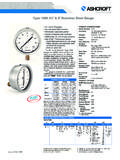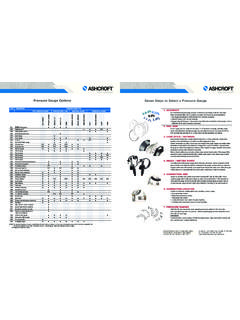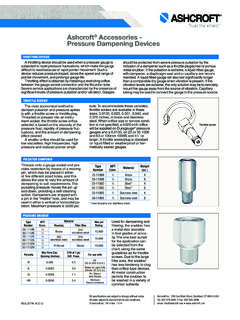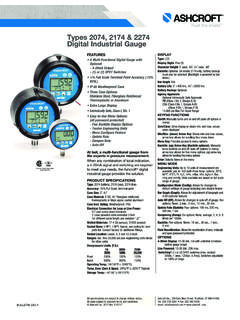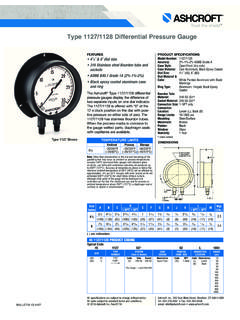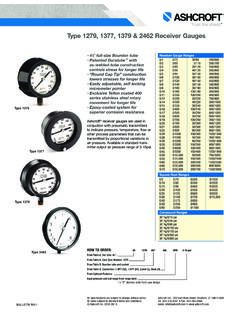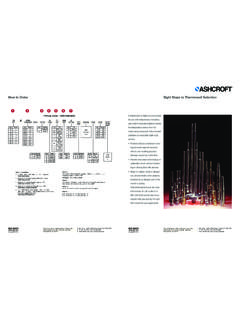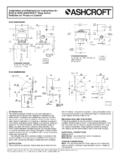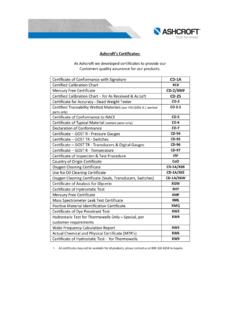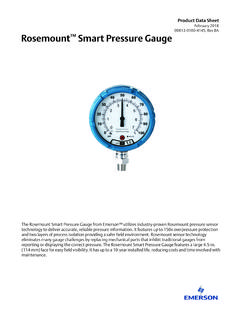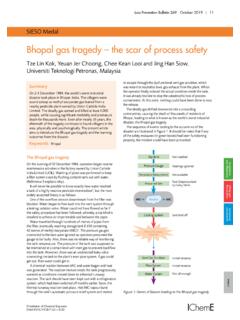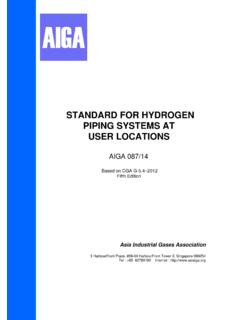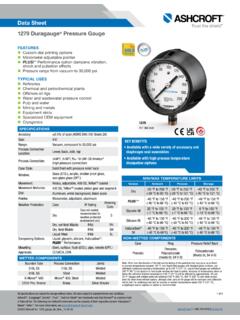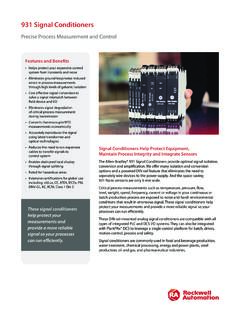Transcription of PRESSURE GAUGE INSTALLATION, OPERATION AND …
1 1 PRESSURE GAUGEINSTALLATION, OPERATION ANDMAINTENANCEI&M008-10098-5/02 (250-1353-L) Rev. 12/1523 PageCover photo courtesy of Johnson/Yokogawa is a registered trademark of Chemiquip Products Co. Selection and Application Range ..4 Temperature ..4 Media ..4 Oxidizing media ..4 Pulsation/Vibration ..4 GAUGE fills ..4 Mounting .. Temperature Ambient Temperature ..4 Accuracy ..4 Steam service ..4 Hot or very cold media ..4 Diaphragm seals ..5 Autoclaving .. installation installation Location.
2 5 GAUGE reuse ..5 Tightening of GAUGE ..5 process isolation ..5 Surface mounting ..5 Flush mounting .. OPERATION Frequency of inspection ..5 In-service inspection ..5 When to check accuracy ..5 When to recalibrate ..5 Other considerations ..5 Spare parts .. GAUGE Replacement .. Accuracy: Procedures/Definitions ..6 Calibration - Rotary movement gauges .. Diaphragm Seals General ..8 installation ..8 OPERATION ..8 Maintenance.
3 8 Failures .. Dampening Devices General ..8 Throttle Screws & Plugs ..8 Ashcroft Pulsation Dampener ..8 Ashcroft PRESSURE Snubber ..8 Ashcroft Needle Valves ..8 Chemiquip PRESSURE Limiting Valves .. Test Equipment & Tool Kits PRESSURE Instrument Testing Equipment ..9 Tools & Tool Kits ..9 Kits to Convert a Dry GAUGE to a Liquid Filled or .. Weather Proof Case GAUGE ..9 21 2& 31 21009 Duralife GAUGE Tools ..10 Appendix Type 1188 Bellows GAUGE Calibration Procedure ..11 Type 1009 Calibration Procedure (Vacuum-Previous Style).
4 12 Type 1009 Calibration Procedure ( PRESSURE -Previous Style) ..13 Type 1009 Calibration Procedure ( PRESSURE & Vacuum-Current Style) ..14 Type 1279 & 1379 I&M Liquid Fill Conversion Instruction ..15-16 Type 1082 Calibration Procedure .. SELECTION & APPLICATIONU sers should become familiar with ASME (Gauges PRESSURE Indicating Dial Type Elastic Element) beforespecifying PRESSURE measuring gauges. That document containing valuable information regarding GAUGE construction,accuracy, safety, selection and testing may be ordered from: ASME International Three Park Avenue New York, 10016-5990800-843-2763 (US/Canada)001-800-843-2763 (Mexico)973-882-1170 outside North Americaemail: prevent misapplication, PRESSURE gaugesshould be selected considering media and ambient operatingconditions.
5 Improper application can be detrimental to thegauge, causing failure and possible personal injury, propertydamage or death. The information contained in this manual isoffered as a guide in making the proper selection of a pressuregauge. Additional information is available from Ashcroft following is a highlight of some of the more important con- Range The range of the instrument should be approxi-mately twice the maximum operating PRESSURE . Too low arange may result in (a) low fatigue life of the elastic elementdue to high operating stress and (b) susceptibility to over- PRESSURE set due to PRESSURE transients that exceed the nor-mal operating PRESSURE . Too high a range may yield insuffi-cient resolution for the Temperature Refer to Section 2 of this manual forimportant information concerning temperature related limita-tions of PRESSURE gauges, both dry and liquid Media The material of the process sensing element mustbe compatible with the process media.
6 Use of a diaphragm sealwith the GAUGE is recommended for process media that (a) iscorrosive to the process sensing element; (b) contain heavyparticulates (slurries) or (c) are very viscous including thosethat harden at room temperature. Oxidizing media Gauges for direct use on oxidizingmedia should be specially cleaned. Gauges for oxygen ser-vice should be ordered to variation X6B and will carry theASME required dial marking USE NO OIL in red for direct use on other oxidizing media may beordered to variation X6W. They will be cleaned but carry nodial marking. PLUS! Performance gauges or Halocarbonfilled GAUGE or diaphragm fill is required for use with oxidiz-ing media; order variation XCF. Pulsation/Vibration PRESSURE pulsation can be damp-ened by several mechanisms; the patented PLUS! Perfor-mancegauge will handle the vast majority of exception to this is high frequency pulsation which isdifficult to detect.
7 The only indication may be an upscale zeroshift due to movement wear. These applications should beaddressed with a liquid filled GAUGE , or in extreme cases, aremotely mounted liquid filled GAUGE connected with a lengthof capillary line. The small diameter of the capillary providesexcellent dampening, but can be plugged. The Ashcroft 1106pulsation dampener and 1112 snubber are auxiliary deviceswhich dampen pulsation with less tendency to GAUGE fills. Once it has been determined that a liquidfilled GAUGE is in order, the next step is selecting the type of most applications. While being the leastexpensive fill, its usable temperature range is 20/180 gauges have a broader service range: 40/250 F. Oxidizing media require the use of Halocarbon,with a service range of 40/250 F. Pointer motion will beslowed at the low end of the low end of these temperatureranges. Mounting Users should predetermine how the gaugewill be mounted in service: stem (pipe), wall (surface) or panel(flush).
8 Ashcroft wall or panel mounting kits should be orderedwiththe GAUGE . See Section Ambient Temperature To ensure long life and accura-cy, PRESSURE gauges should preferably be used at an ambi-ent temperature between 20 and +150 F ( 30 to +65 C). At very low temperatures, standard gauges may exhibit slowpointer response. Above 150 F, the accuracy will be affectedby approximately per 100 F. Other than discoloration ofthe dial and hardening of the gasketing and degradation ofaccuracy, non-liquid filled Type 1279 (phenolic case) and1379 (aluminum case) Duragauge GAUGE , with standardglass windows, can withstand continuous operating tempera-tures up to 250 F. Unigauge models 21 2 and 31 2 1009 and1008S liquid filled gauges can withstand 200 F but glycerinfill and the acrylic window of Duragauge gauges will tend toyellow. Silicone fill will have much less tendency to PRESSURE , liquid filled Types 1008 and 1009 gauges mayhave some downscale errors caused by liquid fill can be alleviated by venting the GAUGE at the top plug(pullout the blue plug insert).
9 To do this the GAUGE must beinstalled in the vertical position. Although the GAUGE may be destroyed and calibration lost,gauges can withstand short times at the following tempera-tures: gauges with all welded PRESSURE boundary joints, 750 F(400 C); gauges with silver brazed joints, 450 F (232 C) andgauges with soft soldered joints, 250 F (121 C). For expectedlong term service below 20 F ( 30 C) Duragauge and 41 2 1009 gauges should be hermetically sealed and speciallylubricated; add H to the product code for hermetic variation XVY for special lubricant. Standard Duralife gauges may be used to 50 F ( 45 C) without Accuracy Heat and cold affect accuracy of general rule of thumb for dry gaugesis of full scalechange for every 40 F change from 75 F. Double that al -lowance for gauges with hermetically sealed or liquid filledcases, except for Duragauge gauges where no extraallowance is required due to the elastomeric, compensatingback.
10 Above 250 F there may exist very significant errors Steam service In order to prevent live steam fromentering the Bourdon tube, a siphon filled with water shouldbe installed between the GAUGE and the process can be supplied with ratings up to 4,000 psi. Iffreezing of the condensate in the loop of the siphon is a pos-sibility, a diaphragm seal should be used to isolate thegauge from the process steam. Siphons should also be usedwhenever condensing, hot vapors (not just steam) are pre-sent. Super heated steam should have enough piping orcapillary line ahead of the siphon to maintain liquid water inthe siphon Hot or very cold media A five foot capillary line assem-bly will bring most hot or cold process media within the recom-mended GAUGE ambient temperature range. For media above45750 F (400 C) the customers should use their own smalldiameter piping to avoid possible corrosion of the stainless five foot capillary will protect the gauges used on the com-mon cryogenic (less than 300 F (200 C) gases, liquid argon,nitrogen, and oxygen.)
